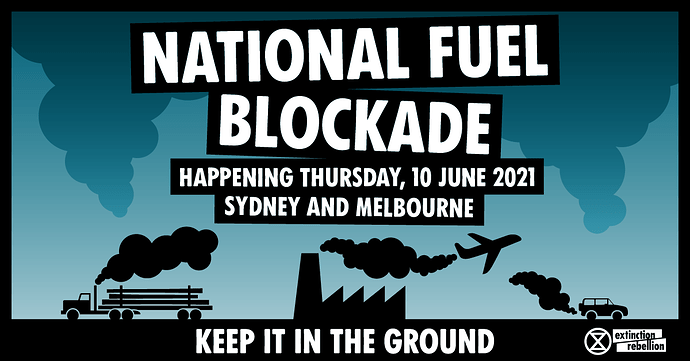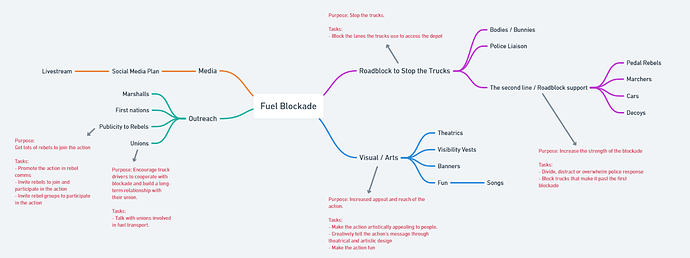Fuel Blockade Action Design Workshop Notes
I held an Action Design Workshop for the fuel blockade on wednesday the 26th of May. I wasn’t aware at the time that the Sydney group were planning an intense series of meetings during the week. The aim of the workshop was to show how purposeful group work can bring an action design towards clarity, with sections on action goals, scenario planning, brainstorming the action parts that need to be organised and allocating people to work on them.
Disclaimer
This workshop was a mental exercise to show how people might go through a brief process of goal-setting, brainstorming and planning to bring an action plan into greater clarity. This session was not a planning session for the action coming up.
Technical Difficulties
My internet suddenly dropped out early in the session and was unable to reconnect for about 10 minutes. I had to reconnect via my phone on a 4g connection and unfortunately was unable to control the breakout rooms which was quite disruptive to the running of the workshop so we were unable to cover all that I had hoped to cover. The workshop was therefore somewhat rushed.
Goals
In a brief section on goals, rebels came up with three clusters of strategic goals for the action:
Messaging:
- Highlight government waste in funding fossil fuels
- Highlight how the government wasn’t acting as if there was a climate emergency
- Highlight fuel insecurity
Grow the Rebellion
- Cause material and financial disruption
- Demonstrate that we are an organized movement exerting power
Form Alliances
- Form alliances with other groups.
Scenario Analyses
Rebels were divided into two small groups to discuss different scenarios for the action and how the action might be designed in these scenarios.
Scenario 1: A dozen rebels, uncooperative truckies and police.
The rebels would have a small roadblock at or outside the fuel terminal driveway, with the bunnies blocking the trucks from moving onto the road.
The bunnies would include some non-threatening rebels, for example an old person with a walking stick. A baby doll in a pram might be present in the roadblock to emphasize the nonviolent disposition of the blockers.
A team of support rebels would aim to de-escalate the situation with the truckies, offering a case of beer and a chat beside the road. Perhaps there could be cake too.
The police liaison would do their job with the police, aiming to delay police and emphasize nonviolence.
The blockers would be arrested or removed by the police at the pace set by the police.
Scenario 2: Hundreds of rebels, uncooperative truckies and police.
This plan would be similar to the above plan. A priority was placed on not cooperating with police orders to move on, but to hold the space. Rebels would try to make use of their numbers to maintain the blockade as long as possible.
There were two main ways proposed that the blockade could be maintained.
The first was through the use of dispersion tactics. There could be a second line of the blockade, forcing the police to either split up into smaller groups or clear one blockade at a time. Non-arrestable rebels would work in groups to increase the disruptiveness of the blockade, with groups on bikes, rebels in cars, marchers or decoy blockades discussed.
The second way to maintain the blockade was through sheer force of numbers. It was suggested that a large number of rebels blocking the road would likely be difficult to clear in a hurry for police, and would also likely receive nothing more than a fine for participating, based on previous experience. It was suggested to emphasize this information in order to encourage large numbers of rebels to put themselves in the bunny position, so that police would struggle to remove the blockade.
Organisation and Planning
We had a quick brainstorm of what was necessary for the action.
- More people -> Publicity for the action
- Messaging and Media strategy -> Amplify the message of the action
- The blockade
- Arrestees that present a dilemma action
- Visual and artistic flair for the action to improve the reach of the action in the media and social media
- Fun and accessible, low-risk roles for participants
This section of the workshop was rushed because of the time lost to technical problems. My intention was to show that the various parts of the action that need to be organized could be divided up into parts. The purpose of each part, and important tasks to do, could be defined by the group. Each of these parts could then be taken up by a rebel or a small group of rebels to design and organize in detail. This would allow the various parts of the plan to be worked on in the time leading up to the action, while also providing a structure into which new volunteers could be added.
At the time of the workshop, around six rebels were interested to be bunnies in the roadblock. There was also a trio of rebels who were interested in organiing a livestream in cooperation with the Melbourne blockade. This showed gaps in organising the second line, the visual / artistic design for the action, social media and media plan beyond the livestream, staff liaison, etc.
Conclusion
This workshop was designed as an exercise to help improve action planning, and I hope it was of benefit to the rebels involved. What is shown above is not a plan for the fuel blockade that is coming up.
As a learning point for future action planning I’d encourage rebels planning a disruptive action to aim to go through a similar planning process many weeks before the action to allow further development of the plan, and more time for publicity to grow the action. I’d be interested to see how a fuel blockade goes where there is a plan 2 months before the action, and 2 months of snowballing promotion of the action to get hundreds of rebels involved in an action that the police may be unable to shut down.
Please let me know if you’d like to talk about this at all!


